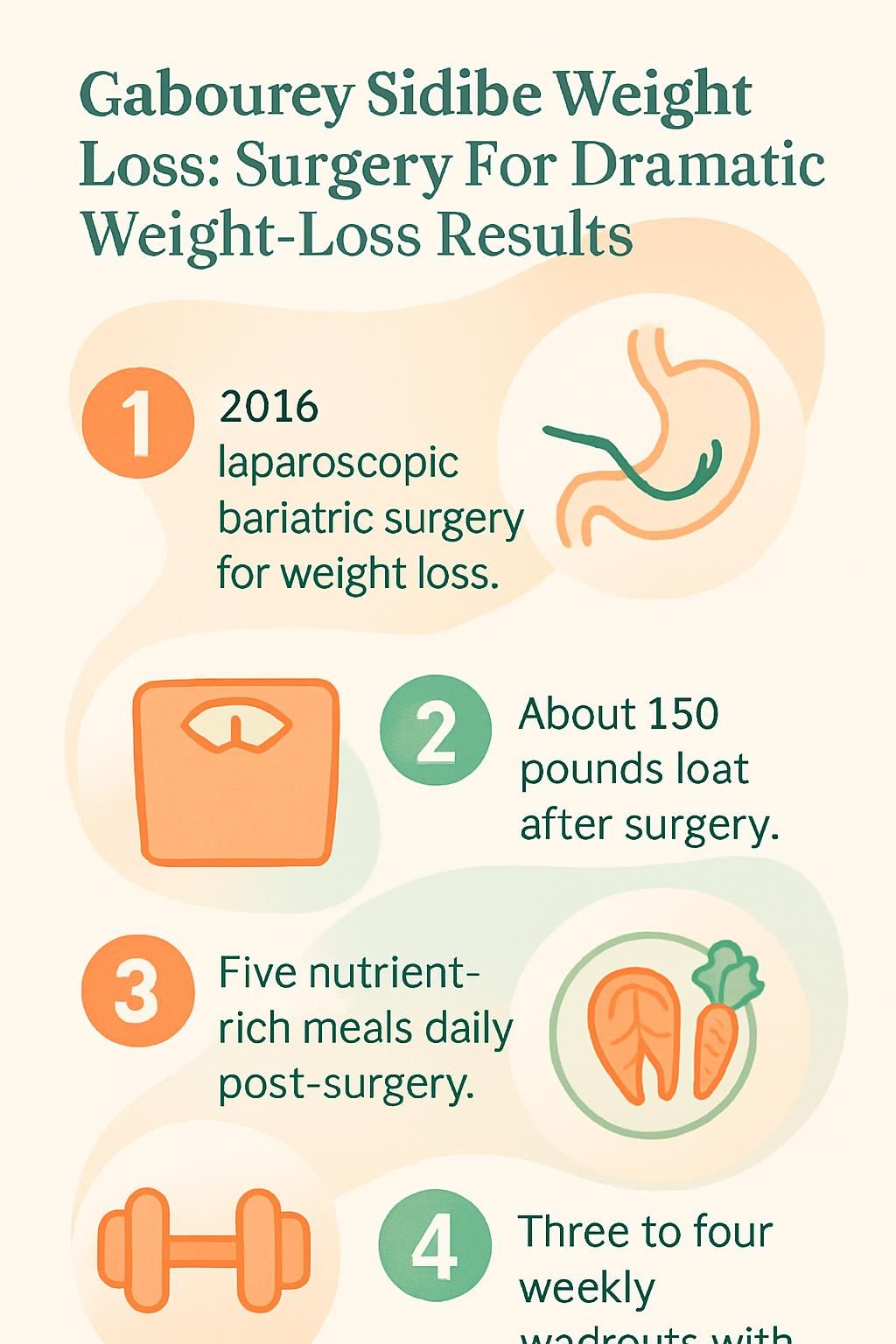Gabourey Sidibe Weight Loss: Surgery For Dramatic Weight-Loss Results
Our Nutrition Assistant AI Suite will transform your body. You will lose fat, get toned, and build muscle. Gain confidence and optimal health.
If you struggle to lose weight or worry about risks like type 2 diabetes, you are not alone. The story of Gabourey Sidibe shows how medical care, including bariatric surgery, can support real change.
Here, you will see why she chose surgery, what the procedure involves, and the daily habits that helped her stay healthy. Her experience offers practical steps you can apply to your own plan for better health.
Key Takeaways
- Gabourey Sidibe had laparoscopic bariatric surgery in 2016 after a type 2 diabetes diagnosis and lost about 150 pounds.
- The laparoscopic approach uses small cuts, which often means less pain and faster recovery, but lasting weight management still depends on healthy daily habits.
- After surgery, she shifted to five small, nutrient-dense meals, cut carbonated drinks and sugary snacks, and exercised three to four days a week with a trainer.
- Long-term success often requires ongoing support, including nutrition guidance, regular exercise, mental health care, and medical follow-up.
- Her openness about physical and mental health challenges helps reduce stigma around weight-loss surgery and promotes focusing on health over outside pressure.

Who Is Gabourey Sidibe?

Gabourey Sidibe is an award-winning actor from New York City. She rose to fame with the lead role in Precious and later shared her weight loss journey with fans.
What was Gabourey Sidibe’s early life and career like?
She grew up in Brooklyn and Harlem. Her mother, Alice Tan Ridley, performed gospel music in subway stations. Her father worked as a taxi driver. Life at home was full of music and grit.
Sidibe faced childhood obesity and unhealthy eating patterns. She attended Mercy College, then City College of New York, before beginning her acting career.
Her breakout came with Precious in 2009. Critics praised her performance at the Sundance Film Festival, and she earned an Academy Award nomination for Best Actress.
Gabourey later appeared in Empire and American Horror Story: Apocalypse. Her path showed how persistence, skill, and support can open doors, even while managing pain, obesity, or self-doubt.
I used to steal food because I was hungry or bored or angry, Sidibe once shared about her early struggles with food.
How has Gabourey Sidibe struggled with weight and health?
Gabourey Sidibe lived with major weight challenges for years, along with public pressure about her size. Doctors warned her about health risks linked to her family history.
In 2016, she was diagnosed with type 2 diabetes. That raised the stakes. She feared serious complications, including infections and even losing toes.
She spoke about being judged for her body in daily life and at work. Many diets and exercise plans came and went. Emotional eating and stress after Precious added to the struggle.
Those ongoing hurdles created constant strain until she chose laparoscopic bariatric surgery. That decision was about health, not image.
The Breaking Point: Gabourey’s Diagnosis
Her diagnosis of type 2 diabetes forced a new plan. It pushed her to choose changes that could protect her health for the long term.
What is type 2 diabetes and how did it affect Gabourey Sidibe?
Type 2 diabetes is a long-term condition where your body resists insulin, the hormone that moves sugar into cells. Blood sugar stays high, which can damage nerves, blood vessels, and organs over time.
Left untreated, it can lead to serious problems, including infections and limb loss. Gabourey faced those risks. Her team urged tighter control through nutrition, activity, and medical options such as bariatric surgery.
That warning shifted her priorities. Health came first, and the plan had to be strong and realistic.
Why did Gabourey decide to prioritize her health?
The diabetes diagnosis in 2016 was a wake-up call. She wanted to lower her risk of heart problems, nerve damage, and reduced mobility.
She explained her motivation:
I truly didn’t want to worry about all the health problems that come with being overweight anymore.
Her goal was comfort, energy, and daily function, not a certain size. She worked with her care team, including a nutrition professional and a trainer, to build a plan she could sustain.
Why Gabourey Sidibe Chose Bariatric Surgery
Gabourey Sidibe chose weight-loss surgery to better manage her health after the diabetes diagnosis. The choice reflected a commitment to a safer, guided path to weight loss with medical support.
What is laparoscopic bariatric surgery? (Bariatric Surgery)
Laparoscopic bariatric surgery is a minimally invasive operation for weight loss. Surgeons use a thin camera, called a laparoscope, through small cuts in the abdomen to reduce stomach size. A smaller stomach helps you feel full sooner, so you eat less.
This approach typically means shorter hospital stays and fewer complications than open surgery. Many patients return to normal activities faster. Some report heading home within a day or two, with less pain than expected.
If diet and exercise alone have not worked, this procedure may help. You still need steady habits afterward, including nutrition goals, movement, and follow-up visits.
What are common misconceptions about weight-loss surgery?
One common myth is that surgery is the easy way out. It is not. Success requires long-term changes, like portion control, daily movement, and mental health support.
Another myth is that results are instant. Weight loss takes time. Gabourey kept her procedure private at first because her body was her business. Public reaction often mixes praise and criticism, which can fuel confusion.
Research shows weight-loss surgery can improve type 2 diabetes for many people, but it is not magic. You still need to practice healthy habits, week after week.
The Surgery Experience
Gabourey Sidibe moved forward with laparoscopic bariatric surgery to support her weight loss goals. Her experience offers a clear look at the process and recovery.
What does the bariatric surgery procedure and recovery involve?
Bariatric surgery supports meaningful weight loss and often leads to quicker recovery than open surgery. Here is a typical path:
- Your surgeon uses laparoscopic tools, making small incisions to reduce trauma and scarring.
- The procedure usually lasts one to two hours, depending on your health and anatomy.
- Many patients, including public figures like Sidibe, go home within two to three days.
- An all-liquid diet starts right after surgery to protect healing.
- Soft foods, then solid foods, are introduced over several weeks, a plan Gabourey described in her memoir, “This Is Just My Face, Try Not to Stare.”
- Light walking begins early to lower blood clot risk and support recovery.
- Follow-up visits track progress, adjust your diet, and check vitamin and mineral levels.
- Short-term help from friends or family can make stairs, shopping, and meal prep easier.
- Emotional care matters. Many people face stress or body image challenges after surgery, which Gabourey also noted.
- Skip carbonated drinks and high-sugar foods to protect the stomach pouch and avoid discomfort.
- A fitness plan or trainer keeps you consistent and helps maintain results.
What emotional and mental challenges did Gabourey face?
After surgery, Gabourey battled worry about her weight and appearance. Daily weigh-ins raised anxiety, so she cut back to every two weeks. That helped, but body image work takes time.
Public attention added pressure. Friends, including Taraji P. Henson, encouraged her during tough moments. Even with steady progress, old fears about food can surface. Many people feel the same way. Therapy and support groups can help break that cycle.
Gabourey Sidibe’s Post-Surgery Transformation
Her post-surgery life brought physical change and new confidence. Progress took patience, steady habits, and support from her team.
How much weight did Gabourey Sidibe lose after surgery?
Gabourey Sidibe lost about 150 pounds after her procedure. That shift improved health and daily comfort. The result did not happen in a week. It took months of structured eating, movement, and follow-up care.
Her story shows what strong effort plus medical treatment can achieve when past methods did not work. It also highlights the value of consistent routines.
How did her body image and confidence change?
Even with weight loss, body image work continued. Public comments did not stop. Some days were easier than others.
Gabourey pushed back on narrow beauty standards and supported body positivity. She shared the truth that self-acceptance can lag behind physical change. Small wins, like better sleep or climbing stairs with ease, became reasons to celebrate.
Lifestyle Changes After Surgery
Her surgery was one step. Daily choices, like food quality and movement, helped protect the results.
What diet changes did Gabourey adopt post-surgery?
Gabourey adopted simple nutrition rules to support long-term weight loss. You can use the same ideas:
- Eat five smaller meals to keep energy steady, as she does now with nutrient-dense options.
- Prioritize lean protein, whole grains, fruits, and vegetables to support healing and muscle.
- Avoid carbonated drinks and sugary snacks to limit discomfort and empty calories.
- Keep portions modest to prevent overeating and stomach pain.
- Work with a nutritionist to tailor a plan to your medical needs and goals.
- Sip water throughout the day to stay hydrated without overfilling your stomach.
- Choose foods rich in vitamins, minerals, and protein instead of processed snacks.
Why did she avoid carbonated drinks and sugary snacks?
Carbonated drinks can cause bloating and pain after surgery. Surgeons often warn that bubbles stretch the stomach and slow healing.
Sugary snacks deliver fast calories with little nutrition. They can trigger dumping syndrome, a sudden wave of nausea, cramps, or weakness after eating high-sugar foods. Cutting soda and candy also helps prevent weight regain.
Switching to water or unsweetened tea can boost energy and reduce headaches. I once traded my afternoon soda for flavored water. Within weeks, I felt less tired and more focused.
How did portion control affect her eating habits?
Portion control turned large plates into smaller, more frequent meals. Eating less at once helped prevent discomfort and kept energy steady.
Research supports this approach. Smaller portions can stabilize hunger and improve digestion. For example, the American Heart Association encourages spreading meals across the day to support blood sugar control.
Practical steps help. Use a smaller plate, measure rice with a scoop, split a sandwich for two meals, and pause to check fullness. These habits build consistency without feeling deprived.
Fitness Routine
Exercise supported her weight loss and mental health. A simple, steady routine works best.
How did working with a personal trainer help Gabourey?
A personal trainer helped Gabourey set clear goals and stay consistent. She trained three to four days per week and used proper form to avoid injury.
Guided sessions built strength and confidence. Professional support can also help you adjust workouts after surgery and stay motivated when progress feels slow.
What exercises did Gabourey incorporate into her routine?
Gabourey added swimming and casual biking to keep workouts fun and low impact. Mixing activities worked different muscles and protected her joints.
She used an Apple Watch to track movement and set reminders. Wearable tech can nudge you to stand, walk, and close activity rings. Those little prompts add up over time.
Mental and Emotional Journey
Weight loss is not only physical. Caring for your mental health helps you stay consistent on hard days.
How did Gabourey overcome depression and anxiety?
Gabourey chose therapy to address depression and anxiety linked to weight and public pressure. A therapist provided tools to handle stress while she worked on nutrition and fitness.
Studies show mental health care can improve outcomes after bariatric surgery (NIH). Combining therapy with lifestyle changes supports both your body and your mind.
How does Gabourey celebrate self-love and body positivity?
Gabourey speaks openly about accepting herself at every size. She shares honest updates, including the hard parts, which makes the journey relatable.
Her message is simple. Care for your health and choose self-respect at each stage. Progress looks different for everyone.
How Gabourey’s Journey Inspires Others
Her story invites you to focus on health and to question old myths about weight and worth.
How does Gabourey break societal stigmas about weight-loss surgery?
Gabourey discusses her weight-loss surgery without shame. She explains the strict diet, exercise, and mindset work that follow the procedure.
Many people fear judgment. Her honesty shows strength, not weakness. Sharing details, like her 2016 diagnosis and decision for laparoscopic bariatric surgery, helps others consider medical care without guilt.
How does she encourage others to focus on their health?
Her message puts health first. She urges people to seek medical guidance, build a supportive team, and make changes that match their lives.
That approach shifts focus from appearance to energy, mobility, and long-term wellbeing. Small steps count, and steady effort pays off.
Lessons Learned From Gabourey Sidibe’s Weight Loss Journey
Her experience offers a clear roadmap. Build better habits, seek support, and keep going, even when progress feels slow.
Why is a balanced diet and exercise important?
Healthy meals and regular movement work together. Food fuels your body, and fitness protects your heart, muscles, and mood.
- Regular activity can cut the risk of heart disease and type 2 diabetes by about 30 percent (CDC).
- A protein-rich, high-fiber diet helps control hunger and supports muscle after weight loss (ASMBS).
Simple steps help. Try daily walks, plan protein at each meal, and get enough sleep. These habits support lasting change after surgery.
When should someone seek professional help for weight loss?
If diet and exercise are not enough, talk with a healthcare professional. Many doctors suggest a visit if your BMI is 30 or higher, or if you have conditions like type 2 diabetes, high blood pressure, or sleep apnea along with excess weight.
In the United States, about 42 percent of adults lived with obesity from 2017 to early 2020, according to the CDC. If you feel stuck or overwhelmed by stress, anxiety, or depression, ask for help. A team can assess your options and keep you safe.
This article is for education, not medical advice. Always consult your clinician before starting any treatment or program.
FAQs About Gabourey Sidibe’s Weight Loss
Here are clear answers to common questions about her journey and bariatric surgery.
What is laparoscopic bariatric surgery? (FAQs)
Laparoscopic bariatric surgery is a minimally invasive procedure that reduces stomach size through tiny abdominal incisions. A camera guides the surgeon. Smaller portions then feel filling, which helps with weight loss. Many patients go home sooner and report less pain than with open surgery.
How long did Gabourey’s weight loss transformation take?
Her transformation started after surgery in 2016. Noticeable changes appeared over the following months as she built steady food and fitness habits.
Timelines vary. Many people see major progress within 12 months, then continue improving with regular follow-up and a consistent routine.
What are Gabourey’s current diet and fitness habits?
She follows a simple plan: five small, nutrient-dense meals, strong portion control, and no sugary snacks or carbonated drinks. That structure helps control hunger and protect her stomach.
She also trains three to four times per week, focusing on strength, cardio, and flexibility. This routine supports long-term weight management and overall health.
Gabourey Sidibe’s Message to Fans
Gabourey invites you to care for your body at every stage and to set goals that fit your life.
How does Gabourey promote loving your body at every stage?
She encourages self-acceptance during each phase of change. Health goals, not outside opinions, guide her choices.
Her updates on interviews and social media often show both the wins and the struggles. That honesty helps many people feel seen.
How can fans take control of their own health journey?
Start with informed choices. Talk with your healthcare team before big changes. Track meals and activity so you can see patterns and adjust.
Set small goals and celebrate milestones. Swap sugary snacks for fruit or yogurt, and add a 20-minute walk most days. Progress builds step by step.
Conclusion
Gabourey Sidibe’s weight loss story shows how bariatric surgery, paired with healthy habits, can help manage weight and conditions like type 2 diabetes. Her honesty reduces stigma around weight-loss surgery and reminds you that every path is personal.
If you are considering this option, speak with your clinician, learn the risks and benefits, and build a support team. Sustainable food choices, regular exercise, and mental health care can help you move toward a healthier life.
FAQs
1. What type of surgery did Gabourey Sidibe have for her weight loss?
Gabourey Sidibe underwent bariatric surgery, a medical procedure that helps people lose weight by changing how the stomach and digestive system work. This type of surgery is often recommended for individuals with obesity who have not achieved results with diet and exercise alone. According to the American Society for Metabolic and Bariatric Surgery, bariatric procedures can lead to significant weight loss and improvement in health conditions related to obesity.
2. How much weight did Gabourey Sidibe lose after her surgery?
Reports indicate that Gabourey Sidibe lost over 150 pounds following her bariatric surgery. Studies show that patients who undergo this type of procedure often experience a reduction of 50 percent or more of their excess body weight within the first year. These results depend on lifestyle changes, including healthy eating habits and regular physical activity.
3. What are the health benefits linked to dramatic weight-loss surgery like Gabourey Sidibe’s?
Weight-loss surgeries such as bariatric procedures can lower risks for diabetes, high blood pressure, heart disease, and sleep apnea. Research published by the National Institutes of Health highlights improved quality of life, increased mobility, and better mental health outcomes for many patients after substantial weight loss.
4. Did Gabourey Sidibe share any personal experiences about her journey with weight loss surgery?
Gabourey Sidibe has spoken publicly about her decision to have bariatric surgery, describing it as a necessary step for her health rather than just appearance. She has discussed facing emotional challenges before and after the procedure but emphasized the importance of support from family, friends, and healthcare professionals throughout her journey.
Summary:
Gabourey Sidibe chose bariatric surgery for significant weight loss after other methods proved ineffective. She lost over 150 pounds, which led to many health benefits supported by medical research. Her personal story highlights both the challenges and positive outcomes associated with surgical intervention for obesity.







